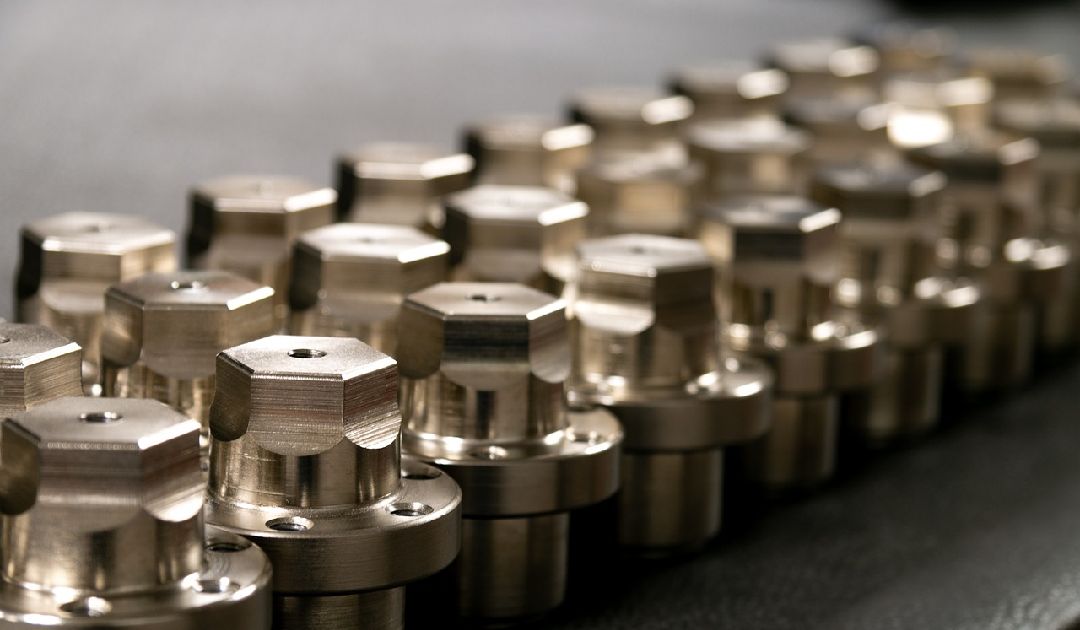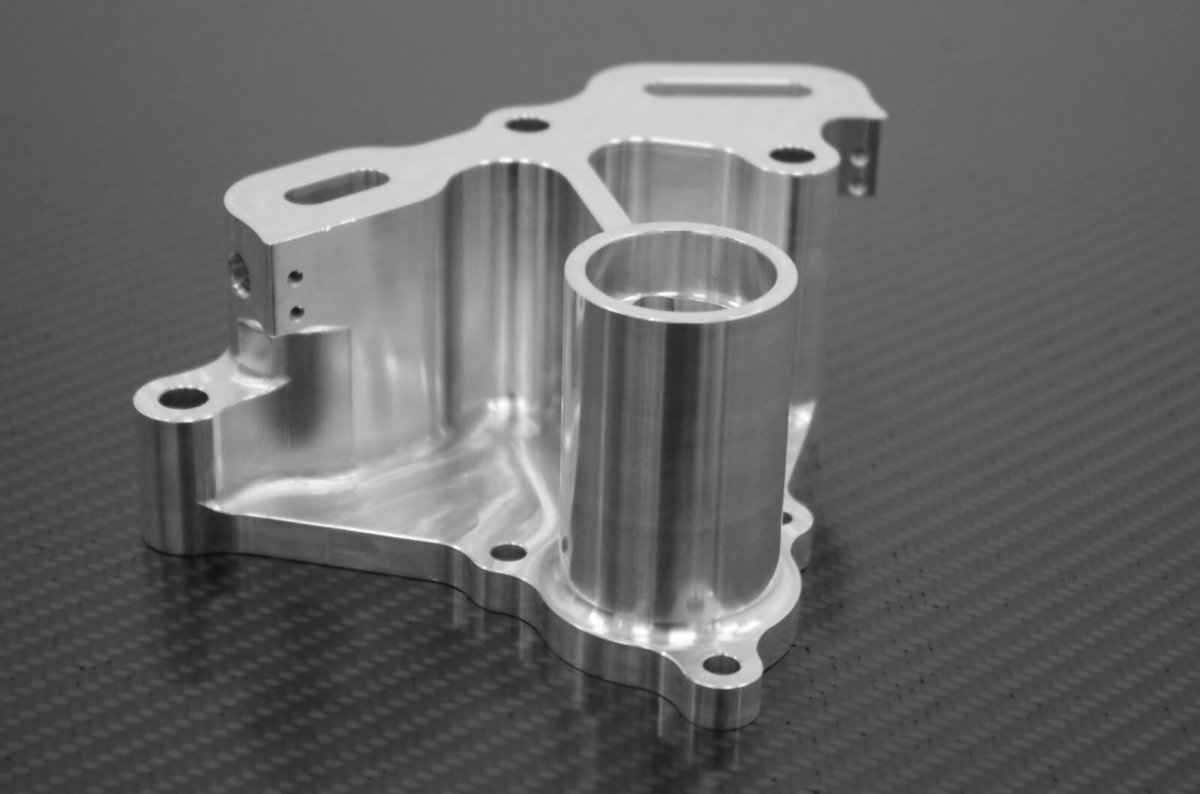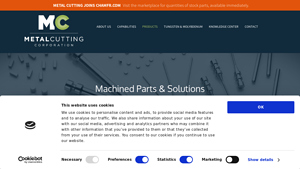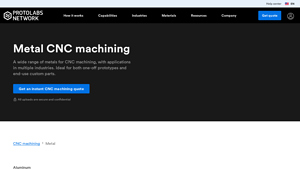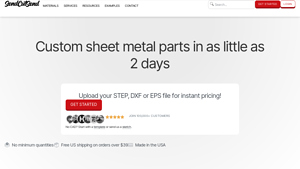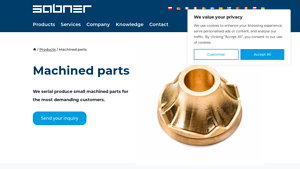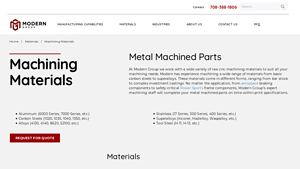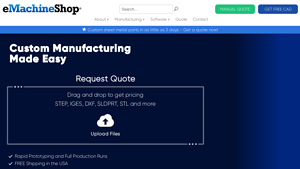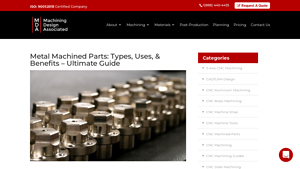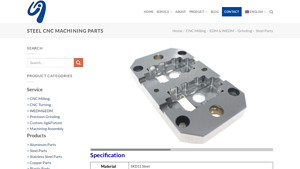Metal Machining Parts Guide: Type, Cost, Top List…
Introduction: Navigating the Global Market for metal machining parts
In today’s competitive global landscape, sourcing high-quality metal machining parts poses a significant challenge for B2B buyers, particularly those operating in diverse regions such as Africa, South America, the Middle East, and Europe. With varying standards, production capabilities, and material requirements, navigating this intricate market can be daunting. This comprehensive guide is designed to equip international buyers with the knowledge needed to make informed purchasing decisions in the complex world of metal machining parts.
We delve into critical aspects such as the different types of machined components, their specific applications across various industries, and effective strategies for vetting suppliers. Understanding cost structures, production timelines, and quality certifications will empower you to choose suppliers who meet your operational needs while ensuring compliance with local and international standards.
By offering actionable insights and practical advice tailored to the unique challenges faced by buyers in regions like Nigeria and Germany, this guide aims to streamline your sourcing process. Whether you are looking for precision components for the aerospace sector or robust parts for industrial machinery, the information contained herein will enhance your procurement strategy, reduce risks, and ultimately drive your business success in the global market.
Understanding metal machining parts Types and Variations
| Type Name | Key Distinguishing Features | Primary B2B Applications | Brief Pros & Cons for Buyers |
|---|---|---|---|
| CNC Machined Parts | High precision, complex geometries, and tight tolerances. | Aerospace, automotive, medical devices. | Pros: Excellent accuracy; Cons: Higher cost for complex designs. |
| Swiss-Style Machined Parts | Capable of producing small, intricate components at high speeds. | Electronics, medical instruments. | Pros: Efficient for small parts; Cons: Limited to smaller dimensions. |
| Turned Parts | Produced using lathe machines, ideal for cylindrical shapes. | Pumps, valves, and fittings. | Pros: Cost-effective for bulk; Cons: Less suitable for complex shapes. |
| Stamped Metal Parts | Created by pressing metal sheets into desired shapes. | Automotive body parts, appliances. | Pros: High volume production; Cons: Initial tooling costs can be high. |
| Refractory Metal Components | Made from materials like tungsten or molybdenum, resistant to extreme conditions. | Aerospace, high-temperature applications. | Pros: Durable under extreme conditions; Cons: More expensive materials. |
What Are CNC Machined Parts and Their Applications?
CNC (Computer Numerical Control) machined parts are characterized by their high precision and ability to produce complex geometries with tight tolerances, often within ±0.0005 inches. This technology is widely used in sectors such as aerospace, automotive, and medical devices, where accuracy is critical. When purchasing CNC machined parts, buyers should consider the complexity of their designs, as intricate components may lead to higher costs and longer lead times.
What Makes Swiss-Style Machined Parts Unique?
Swiss-style machining is specifically designed for producing small, intricate components at high speeds. This method excels in the production of parts for electronics and medical instruments, where precision and miniaturization are paramount. B2B buyers should evaluate the size and complexity of the components they need, as Swiss-style machining is limited to smaller dimensions but offers exceptional efficiency for such applications.
How Are Turned Parts Manufactured and What Are Their Uses?
Turned parts are manufactured using lathe machines that rotate the workpiece against a cutting tool to create cylindrical shapes. This method is ideal for applications in pumps, valves, and fittings, where parts are often produced in bulk. Buyers should consider the volume of parts required and the simplicity of the design, as turned parts are cost-effective for high-volume orders but less suitable for intricate geometries.
What Are Stamped Metal Parts and Their Benefits?
Stamped metal parts are produced by pressing metal sheets into desired shapes using specialized dies. They are commonly used in the automotive industry for body parts and in appliances. While stamping offers the advantage of high-volume production at lower costs, buyers should be aware that the initial tooling costs can be significant, making it more suitable for long-run production rather than one-off projects.
Why Choose Refractory Metal Components?
Refractory metal components are crafted from materials like tungsten and molybdenum, known for their resistance to extreme temperatures and harsh environments. These components are essential in industries such as aerospace and high-temperature applications. Buyers should factor in the higher material costs and specialized manufacturing processes when considering refractory metals, as they deliver unparalleled durability in challenging conditions.
Key Industrial Applications of metal machining parts
| Industry/Sector | Specific Application of metal machining parts | Value/Benefit for the Business | Key Sourcing Considerations for this Application |
|---|---|---|---|
| Aerospace | Precision components for aircraft engines and structures | Enhanced performance, safety, and compliance with regulations | Certifications (e.g., AS9100), material traceability, and tight tolerances |
| Medical Devices | Custom machined parts for surgical instruments and implants | Improved patient outcomes and device reliability | Biocompatibility, sterilization requirements, and regulatory compliance (e.g., ISO 13485) |
| Automotive | Engine and transmission components | Increased efficiency and durability of vehicles | Material specifications, performance testing, and supply chain reliability |
| Electronics | Connectors and housings for electronic devices | Enhanced functionality and durability of products | Precision machining capabilities, material selection, and design flexibility |
| Oil & Gas | Custom fittings and valves for drilling equipment | Improved operational efficiency and safety | Material strength, corrosion resistance, and compliance with industry standards |
How Are Metal Machining Parts Utilized in the Aerospace Industry?
In the aerospace sector, metal machining parts are critical for manufacturing precision components used in aircraft engines and structural applications. These parts must meet stringent safety and performance standards, necessitating high-quality materials and precise tolerances. International buyers from regions like Europe and the Middle East should prioritize suppliers with AS9100 certification and robust material traceability to ensure compliance with aerospace regulations.
What Are the Applications of Machined Parts in Medical Devices?
Metal machining plays a vital role in producing custom parts for medical devices, including surgical instruments and implants. These components must be biocompatible and capable of withstanding sterilization processes. For B2B buyers in Africa and South America, sourcing from manufacturers with ISO 13485 certification is essential to guarantee adherence to medical device regulations and to ensure the safety and reliability of products.
How Do Automotive Manufacturers Benefit from Metal Machining?
In the automotive industry, machined metal parts are essential for the production of engine and transmission components. These parts contribute to the overall efficiency and durability of vehicles, which are crucial for maintaining competitive advantage. Buyers must consider suppliers that can provide detailed material specifications and conduct rigorous performance testing, especially in regions like Nigeria where automotive standards are evolving.
What Role Do Machined Parts Play in Electronics Manufacturing?
Machined metal parts are integral to the electronics industry, where they are used in connectors and housings for various electronic devices. These components enhance product durability and functionality, addressing the increasing demand for reliable electronic solutions. For international buyers, especially in Europe, evaluating suppliers based on their precision machining capabilities and flexibility in design is critical to meet diverse project requirements.
How Are Metal Machining Parts Used in the Oil and Gas Sector?
In the oil and gas industry, custom machined parts such as fittings and valves are vital for drilling equipment. These components must exhibit exceptional strength and corrosion resistance to withstand harsh operating conditions. Buyers from regions like the Middle East should focus on sourcing from manufacturers who comply with industry standards and can provide assurance of material integrity and performance in demanding environments.
3 Common User Pain Points for ‘metal machining parts’ & Their Solutions
Scenario 1: Quality Control and Tolerance Issues in Custom Parts Production
The Problem: B2B buyers often face significant challenges when sourcing metal machining parts, particularly regarding quality control and achieving precise tolerances. In industries such as aerospace or medical devices, even minor deviations can lead to product failures, safety issues, or costly recalls. Buyers may struggle with suppliers who cannot consistently meet tight tolerances, resulting in increased scrutiny of parts upon delivery and potential delays in production schedules. This situation not only strains relationships with end customers but can also lead to financial losses.
The Solution: To mitigate these risks, buyers should prioritize partnering with ISO-certified manufacturers that specialize in the required tolerances for their specific applications. When sourcing, inquire about the supplier’s quality assurance processes, including their use of advanced CNC machining technologies and inspection methods like Coordinate Measuring Machines (CMM) to ensure parts meet specified tolerances. Establishing clear communication channels and specifying detailed engineering drawings can also prevent misunderstandings regarding part specifications. Regular audits and performance evaluations of suppliers can further enhance confidence in their ability to deliver quality parts.
Scenario 2: High Lead Times and Delays in Production
The Problem: Many buyers experience frustration with long lead times when ordering custom metal machining parts, which can severely disrupt their production timelines. This issue is particularly prevalent when working with suppliers who have limited capacity or inefficient processes. For manufacturers in fast-paced industries, these delays can result in missed deadlines, lost contracts, and a damaged reputation, as they struggle to meet customer demands in a timely manner.
The Solution: To address lead time challenges, buyers should consider utilizing suppliers with a robust network of manufacturing capabilities and advanced technologies, such as CNC machining with multi-axis capabilities. This approach not only allows for faster turnaround times but also enables the production of complex geometries in fewer operations. Establishing a just-in-time (JIT) inventory strategy can also help manage supply needs dynamically, ensuring that parts are available exactly when needed without overstocking. Moreover, buyers should communicate their timelines and urgency clearly with suppliers to align expectations and explore options for expedited services.
Scenario 3: Material Selection and Compatibility Concerns
The Problem: Selecting the right material for metal machining parts can be daunting for buyers, especially when considering factors such as strength, corrosion resistance, and cost. Misalignment between material properties and application requirements can lead to component failures or subpar performance in the field. This is particularly critical in sectors like automotive and aerospace, where safety and reliability are paramount. Buyers may also face challenges in sourcing specific alloys or materials that meet regulatory standards.
The Solution: To overcome material selection challenges, buyers should engage with suppliers who offer expertise in materials science and can provide guidance based on the specific application needs. Conducting thorough research on material properties and performance under expected conditions is crucial. Utilize suppliers that provide access to a wide range of materials, including exotic alloys and standard options, while ensuring that they can meet industry-specific certifications. Additionally, consider utilizing simulation software to predict how materials will behave under operational stress, thus informing more strategic decisions. Regular consultation with engineering teams can also refine material specifications to ensure compatibility and performance.
Strategic Material Selection Guide for metal machining parts
What Are the Key Properties of Aluminum for Machined Parts?
Aluminum is one of the most widely used materials in metal machining due to its excellent machinability and favorable strength-to-weight ratio. It exhibits good corrosion resistance, making it suitable for various environments, including those that involve moisture and chemicals. Aluminum can withstand moderate temperatures, typically up to 150°C (302°F), which makes it ideal for applications in automotive and aerospace sectors.
Pros & Cons: The primary advantages of aluminum include its lightweight nature, ease of machining, and cost-effectiveness. However, it may not be suitable for high-stress applications due to its lower strength compared to other metals like steel. Additionally, while aluminum is relatively inexpensive, its cost can increase significantly with specialized alloys.
Impact on Application: Aluminum is compatible with a range of media, including water and various oils, making it suitable for automotive and industrial applications. However, it should be avoided in environments with strong alkalis or acids, which can corrode the material.
Considerations for International Buyers: Buyers from regions such as Africa and South America should consider local availability and compliance with international standards like ASTM and DIN. In Europe, specific alloy grades may be preferred, and buyers should ensure that suppliers can meet these standards.
How Does Stainless Steel Compare in Machining Applications?
Stainless steel is renowned for its high tensile strength, corrosion resistance, and ability to withstand extreme temperatures. It is commonly used in industries such as food processing, medical devices, and construction due to its durability and hygienic properties. Stainless steel can handle temperatures up to 800°C (1472°F) depending on the grade, making it versatile for various applications.
Pros & Cons: The key advantages of stainless steel include its strength, resistance to rust and corrosion, and aesthetic appeal. However, it can be more challenging to machine compared to aluminum, leading to higher manufacturing costs and longer lead times. Additionally, certain grades of stainless steel may be significantly more expensive than aluminum or mild steel.
Impact on Application: Stainless steel’s compatibility with harsh environments, such as those involving saltwater or acidic substances, makes it a preferred choice for marine and chemical processing applications. Its durability also ensures a longer lifespan for components, reducing the need for frequent replacements.
Considerations for International Buyers: Buyers in the Middle East and Europe should be aware of the various grades of stainless steel available and their compliance with standards such as ASTM A240 or EN 10088. Understanding the specific requirements for corrosion resistance in their respective industries is crucial.
What Are the Benefits of Using Brass in Machined Components?
Brass, an alloy of copper and zinc, is favored for its excellent machinability and low friction properties. It is often used in applications requiring good electrical conductivity, such as electrical connectors and switches. Brass components can typically handle temperatures up to 200°C (392°F) without significant degradation.
Pros & Cons: The primary advantage of brass is its excellent workability and corrosion resistance, particularly in marine environments. However, it is generally more expensive than aluminum and mild steel, and its mechanical strength is lower than that of stainless steel. Additionally, brass can be prone to dezincification in certain environments, which can affect its durability.
Impact on Application: Brass is highly suitable for applications involving electrical components due to its conductivity. However, it may not be ideal for high-pressure applications, where stronger materials like stainless steel or titanium would be more appropriate.
Considerations for International Buyers: Buyers should ensure that the brass alloys they choose meet international standards such as ASTM B36 or JIS H3250. Additionally, understanding local regulations regarding the use of copper-based alloys is essential, especially in regions with strict environmental regulations.
Why Choose Titanium for High-Performance Machined Parts?
Titanium is known for its exceptional strength-to-weight ratio and corrosion resistance, making it a top choice for aerospace, medical, and high-performance applications. It can withstand temperatures exceeding 600°C (1112°F) and is highly resistant to oxidation and corrosion in harsh environments.
Pros & Cons: The key advantage of titanium is its outstanding strength, which allows for thinner components without sacrificing durability. However, it is one of the most expensive materials to machine due to its toughness, which can lead to higher manufacturing costs and complexity in machining processes.
Impact on Application: Titanium’s compatibility with aggressive media, including saltwater and acids, makes it ideal for marine and chemical applications. Its biocompatibility also makes it a preferred choice for medical implants and devices.
Considerations for International Buyers: Buyers must consider the availability of titanium alloys in their regions and ensure compliance with standards such as ASTM F136 for medical applications. Understanding the cost implications and machining capabilities of suppliers is also critical for effective procurement.
| Material | Typical Use Case for metal machining parts | Key Advantage | Key Disadvantage/Limitation | Relative Cost (Low/Med/High) |
|---|---|---|---|---|
| Aluminum | Automotive and aerospace components | Lightweight and easy to machine | Lower strength compared to steel | Medium |
| Stainless Steel | Medical devices and food processing | High strength and corrosion resistance | More difficult to machine | High |
| Brass | Electrical connectors and fittings | Excellent conductivity and machinability | Prone to dezincification | Medium |
| Titanium | Aerospace and medical implants | Exceptional strength-to-weight ratio | High machining costs | High |
In-depth Look: Manufacturing Processes and Quality Assurance for metal machining parts
What Are the Main Stages of Manufacturing Metal Machining Parts?
The manufacturing process for metal machining parts typically involves several key stages: material preparation, forming, assembly, and finishing. Each stage is critical for ensuring the final product meets specific quality and performance standards.
Material Preparation: How Is Raw Material Processed?
The first step in manufacturing involves selecting and preparing the raw material. This can include metals like aluminum, stainless steel, brass, and titanium, each chosen for its unique properties. The material is often cut into manageable sizes, ensuring it is free from defects. Techniques such as annealing and hardening may be employed to enhance the material’s machinability and mechanical properties.
Forming: What Techniques Are Used in Metal Machining?
Once the material is prepared, the forming stage begins. This is where the actual machining occurs, typically using CNC (Computer Numerical Control) machines. CNC milling and turning are common techniques employed to achieve precise dimensions and intricate designs. Advanced machines, such as 4-axis and 5-axis CNC systems, allow for complex geometries to be machined efficiently. Additionally, processes like wire EDM (Electrical Discharge Machining) are utilized for creating fine details in hard-to-machine materials.
Assembly: How Are Components Brought Together?
For parts requiring multiple components, assembly becomes essential. This stage may involve fastening, welding, or bonding parts together to create a final product. Careful alignment and fitment are crucial to ensure functionality, especially in applications where precision is paramount, such as in aerospace or medical devices.
Finishing: What Are the Final Steps in Metal Machining?
Finishing processes enhance the appearance and performance of the machined parts. Techniques such as grinding, polishing, and coating are commonly used. Surface treatments, such as anodizing or passivation, improve corrosion resistance and wear properties. This stage is vital for ensuring that the parts not only meet aesthetic standards but also perform reliably in their intended applications.
What Quality Assurance Practices Are Commonly Used in Metal Machining?
Quality assurance is a critical aspect of the manufacturing process, particularly for B2B buyers who require consistent and reliable products. Various international and industry-specific standards guide the quality assurance practices in metal machining.
Which International Standards Should B2B Buyers Be Aware Of?
ISO 9001:2015 is a widely recognized international standard for quality management systems. It provides a framework for companies to ensure consistent quality in their processes and products. Additionally, industry-specific certifications like ISO 13485 for medical devices, IATF 16949 for automotive, and AS9100 for aerospace can further assure buyers of a supplier’s commitment to quality.
What Are the Key Quality Control Checkpoints?
Quality control checkpoints throughout the manufacturing process include:
- Incoming Quality Control (IQC): This involves inspecting raw materials upon receipt to ensure they meet specified requirements.
- In-Process Quality Control (IPQC): Ongoing inspections during the machining process help detect any deviations from specifications early on.
- Final Quality Control (FQC): At this stage, finished products are rigorously tested against pre-defined quality standards before they are shipped to customers.
What Testing Methods Are Commonly Used for Metal Machining Parts?
Testing methods can vary based on the intended application of the machined parts. Common techniques include:
- Dimensional Inspection: Using precision measuring tools to verify that parts meet specified tolerances.
- Non-Destructive Testing (NDT): Techniques such as ultrasonic testing and X-ray inspection help identify internal flaws without damaging the part.
- Functional Testing: Ensuring that the part performs as intended in its final application.
How Can B2B Buyers Verify Supplier Quality Control?
For international B2B buyers, verifying a supplier’s quality control processes is essential. Here are actionable steps to ensure compliance with quality standards:
What Auditing Processes Should Buyers Consider?
Conducting supplier audits can provide valuable insights into a manufacturer’s quality practices. Buyers should look for suppliers who welcome third-party audits and have established procedures for addressing any identified issues.
How Important Are Quality Reports and Documentation?
Requesting quality reports and documentation is crucial for transparency. Suppliers should be able to provide certificates of compliance, test reports, and material certifications. This documentation offers reassurance that the products meet international standards and specifications.
What Role Do Third-Party Inspections Play in Quality Assurance?
Engaging third-party inspection services can add an additional layer of assurance. These independent entities can conduct inspections at various stages of the manufacturing process, providing unbiased evaluations of the quality of the parts being produced.
What Are the Specific Quality Control Nuances for International B2B Buyers?
B2B buyers from diverse regions, including Africa, South America, the Middle East, and Europe, may encounter unique challenges in quality assurance. Understanding regional standards and expectations is crucial.
How Do Regional Standards Affect Quality Assurance?
Buyers should familiarize themselves with local regulations and standards that may impact their procurement processes. For instance, CE marking is essential for products sold in the European market, while API certification is critical for oil and gas applications.
What Should Buyers Look For in Supplier Certifications?
When considering suppliers, it is important to check for relevant certifications that align with their industry requirements. This can help ensure that the supplier is capable of meeting the necessary quality standards and is committed to continuous improvement.
In summary, understanding the manufacturing processes and quality assurance practices for metal machining parts is vital for B2B buyers. By focusing on material preparation, forming techniques, assembly, finishing, and rigorous quality control measures, buyers can make informed decisions and establish reliable partnerships with suppliers.
Practical Sourcing Guide: A Step-by-Step Checklist for ‘metal machining parts’
Introduction
Navigating the procurement of metal machining parts can be complex, especially for international B2B buyers. This step-by-step checklist is designed to streamline the sourcing process, ensuring that you identify high-quality suppliers capable of meeting your specific needs. By following these actionable steps, you can make informed decisions and establish lasting partnerships.
Step 1: Define Your Technical Specifications
Clearly outlining your technical requirements is essential for effective sourcing. This includes dimensions, tolerances, materials, and surface finishes. Providing detailed specifications ensures that potential suppliers understand your needs and can deliver parts that meet your quality standards.
- Considerations:
- Specify the type of metal required (e.g., aluminum, stainless steel, titanium).
- Detail any unique features or complex geometries that the parts must have.
Step 2: Research Potential Suppliers
Conduct thorough research to identify suppliers with a proven track record in metal machining. Look for companies that specialize in your required materials and have experience in your industry.
- Action Items:
- Utilize online directories and industry-specific platforms.
- Check for reviews and testimonials from previous clients to gauge reliability.
Step 3: Evaluate Supplier Capabilities
Before committing to a supplier, assess their machining capabilities to ensure they align with your project requirements. This includes understanding their machinery, technology, and production processes.
- Key Questions:
- What types of CNC machines do they operate?
- Can they handle the required tolerances and production volumes?
Step 4: Verify Supplier Certifications
Certifications can be a strong indicator of a supplier’s commitment to quality and industry standards. Ensure that the suppliers you consider hold relevant certifications such as ISO 9001 or AS9100D, especially if you operate in regulated industries.
- Why It Matters:
- Certifications demonstrate adherence to quality management practices.
- They can reduce risks associated with poor-quality parts and compliance issues.
Step 5: Request Quotes and Compare Pricing
Once you have identified potential suppliers, request quotes for your specific requirements. This will help you understand the cost structure and evaluate the price competitiveness of each supplier.
- Tip:
- Ensure that quotes are itemized to compare the costs of materials, labor, and any additional services.
Step 6: Assess Lead Times and Production Capacity
Understanding the lead times for production and delivery is crucial for planning your supply chain. Discuss the supplier’s capacity to meet your timelines, especially for urgent or large orders.
- Important Considerations:
- Confirm their ability to scale production if your needs increase.
- Inquire about their process for handling delays or unexpected issues.
Step 7: Establish Communication Protocols
Effective communication is vital for a successful partnership. Establish clear lines of communication regarding project updates, quality concerns, and any potential changes in specifications.
- Best Practices:
- Assign a dedicated contact person for ongoing interactions.
- Utilize project management tools for tracking progress and feedback.
By following this checklist, B2B buyers can enhance their sourcing strategy for metal machining parts, ensuring they partner with the right suppliers to meet their operational demands.
Comprehensive Cost and Pricing Analysis for metal machining parts Sourcing
What Are the Key Cost Components in Metal Machining Parts Sourcing?
Understanding the cost structure of metal machining parts is crucial for B2B buyers. The primary components influencing cost include materials, labor, manufacturing overhead, tooling, quality control (QC), logistics, and supplier margin.
-
Materials: The choice of metal significantly impacts pricing. Common materials like aluminum or stainless steel can be less expensive compared to specialty alloys such as titanium or Inconel. Pricing can fluctuate based on market conditions and availability.
-
Labor: Skilled labor is essential in machining, especially for complex parts that require tight tolerances. Labor costs vary by region; for instance, labor may be more costly in Europe than in parts of Africa or South America.
-
Manufacturing Overhead: This encompasses the costs associated with running machinery, utilities, and facility maintenance. High-tech CNC machines and advanced tooling systems can increase overhead costs, but they also enhance efficiency and precision.
-
Tooling: Initial tooling costs can be significant, especially for custom parts. The tooling must be designed to the specific requirements of the part, and this upfront investment can be amortized over large production runs.
-
Quality Control: Robust QC processes ensure that parts meet specifications, which is particularly critical for industries such as aerospace and medical. Increased QC measures can raise costs but may prevent expensive reworks or failures later in the production process.
-
Logistics: Shipping costs can add up, especially for international buyers. Factors such as distance, shipping mode, and customs duties must be considered. Incoterms can also influence logistics costs and responsibilities.
-
Margin: Suppliers typically add a margin to cover their costs and profit. This margin can vary based on the supplier’s market position, service level, and the competitiveness of their offerings.
How Do Price Influencers Affect Metal Machining Costs?
Several factors can influence the pricing of metal machining parts, particularly in an international B2B context.
-
Volume and Minimum Order Quantity (MOQ): Larger orders often lead to lower unit prices due to economies of scale. Buyers should negotiate MOQs that align with their needs while maximizing cost efficiency.
-
Specifications and Customization: Highly customized parts with specific tolerances or surface finishes can increase costs. Standard parts may be more economical due to established production processes.
-
Material Selection: The choice of material not only affects the base price but also influences machining time and tooling wear. Buyers should balance material performance requirements with cost considerations.
-
Quality and Certifications: Parts requiring industry certifications (ISO, AS9100) may incur higher costs due to additional compliance and documentation processes. Ensure that suppliers can meet necessary standards without inflating costs unnecessarily.
-
Supplier Factors: The supplier’s location, reputation, and production capabilities can significantly affect pricing. Engaging with local suppliers may reduce shipping costs but could limit material options or manufacturing capabilities.
-
Incoterms: Understanding Incoterms is vital for international transactions, as they define the responsibilities of buyers and sellers regarding shipping, insurance, and tariffs. This can have a direct impact on the overall cost structure.
What Are the Best Practices for B2B Buyers to Optimize Costs?
B2B buyers can adopt several strategies to enhance cost efficiency in sourcing metal machining parts:
-
Negotiate Wisely: Leverage volume purchasing and long-term contracts to negotiate better pricing and terms. Building strong relationships with suppliers can also yield favorable pricing adjustments.
-
Consider Total Cost of Ownership (TCO): Evaluate not just the initial price, but all costs associated with the part, including shipping, QC, and potential downtime due to part failures. This holistic view can uncover hidden costs that affect overall profitability.
-
Be Mindful of Pricing Nuances for International Transactions: Different regions have varying pricing structures due to labor costs, material availability, and economic conditions. Be aware of these factors when sourcing from countries like Nigeria or Germany.
-
Seek Multiple Quotes: Obtain quotes from several suppliers to compare pricing structures and service offerings. This can provide leverage in negotiations and help identify the best value.
-
Stay Informed on Market Trends: Regularly monitor market conditions for materials and machining technology advancements. Staying informed can help buyers anticipate price changes and adjust their sourcing strategies accordingly.
By understanding the intricate cost structure and pricing influencers in metal machining parts sourcing, B2B buyers can make informed decisions that lead to significant savings and improved operational efficiency.
Alternatives Analysis: Comparing metal machining parts With Other Solutions
Exploring Alternatives to Metal Machining Parts
In the realm of manufacturing, particularly for international B2B buyers, understanding the alternatives to metal machining parts is essential for making informed decisions. While metal machining offers precision and versatility, other solutions may provide unique advantages depending on specific project requirements. This section examines two viable alternatives: additive manufacturing (3D printing) and injection molding.
Comparison of Metal Machining Parts and Alternatives
| Comparison Aspect | Metal Machining Parts | Additive Manufacturing (3D Printing) | Injection Molding |
|---|---|---|---|
| Performance | High precision with tight tolerances | Suitable for complex geometries | High volume production efficiency |
| Cost | Higher initial setup costs | Cost-effective for low volumes | High upfront tooling costs |
| Ease of Implementation | Requires skilled operators and setup | User-friendly for prototyping | Complex setup, less flexible for design changes |
| Maintenance | Regular maintenance of machines | Minimal maintenance | Requires mold maintenance |
| Best Use Case | Precision parts, tight tolerances | Prototyping, low-volume production | High-volume production runs |
Understanding Additive Manufacturing (3D Printing)
Additive manufacturing, commonly known as 3D printing, builds parts layer by layer from digital models. This method excels in producing intricate designs that may be impossible or cost-prohibitive with traditional machining. The primary advantages include lower costs for small batch production and rapid prototyping capabilities. However, while 3D printing can offer significant flexibility in design, the material properties may not match those produced through machining, especially for high-stress applications.
Evaluating Injection Molding
Injection molding is a manufacturing process that involves injecting molten material into a mold to create parts. This method is highly efficient for producing large quantities of identical items, making it ideal for consumer products and components that require uniformity. The main drawback is the significant upfront costs associated with creating molds, which can be prohibitive for small production runs. Additionally, design changes after mold creation can be costly and time-consuming, limiting flexibility.
Conclusion: Choosing the Right Solution for Your Needs
When selecting between metal machining parts and alternative manufacturing methods, B2B buyers must consider their specific requirements, including production volume, material properties, and design complexity. Metal machining is optimal for high-precision applications, while additive manufacturing is advantageous for rapid prototyping and custom designs. Injection molding shines in high-volume scenarios but comes with higher initial costs and reduced flexibility. Evaluating these factors will help buyers choose the most suitable solution that aligns with their operational goals and budget constraints.
Essential Technical Properties and Trade Terminology for metal machining parts
What Are the Key Technical Properties of Metal Machining Parts?
Understanding the essential technical properties of metal machining parts is crucial for B2B buyers to ensure that the components meet specific operational requirements. Here are some critical specifications:
1. Material Grade
The material grade refers to the specific classification of metals based on their chemical composition and mechanical properties. Common grades include stainless steel (like 316L), aluminum alloys, and tool steels. Each grade offers distinct advantages, such as corrosion resistance in stainless steels or lightweight properties in aluminum, making it vital for buyers to select the appropriate material based on the application’s demands.
2. Tolerance
Tolerance defines the permissible limit of variation in a physical dimension of a part. In metal machining, tolerances can be as tight as ±0.0005 inches. High tolerance levels are essential for parts that require precise fitting and function, especially in industries like aerospace or medical devices, where even minor deviations can lead to significant failures or inefficiencies.
3. Surface Finish
Surface finish refers to the texture of a surface after machining. It can impact the performance and aesthetic appeal of a part. Common finishes include anodized, polished, and matte. In B2B contexts, the required surface finish can affect friction, wear resistance, and the overall longevity of the component, making it an essential consideration during the procurement process.
4. Machining Process
Different machining processes, such as CNC milling, turning, or electrical discharge machining (EDM), impact the final properties of the parts. Each method has its advantages, such as CNC machining being suitable for complex geometries and tight tolerances. Understanding these processes allows buyers to make informed decisions about cost, lead time, and suitability for their specific applications.
5. Heat Treatment
Heat treatment involves processes like annealing or quenching that enhance the mechanical properties of metals, such as hardness and strength. This property is crucial for parts subjected to high stress or extreme environments. Buyers should consider whether the components require specific heat treatments to ensure performance and durability.
Which Trade Terms Should B2B Buyers Know in Metal Machining?
Familiarity with industry-specific terminology can greatly enhance communication and negotiation between buyers and suppliers. Here are some commonly used terms:
1. OEM (Original Equipment Manufacturer)
OEM refers to companies that produce parts or equipment that may be marketed by another manufacturer. Understanding the OEM concept is vital for buyers seeking reliable components that meet original specifications for their products.
2. MOQ (Minimum Order Quantity)
MOQ is the smallest number of units a supplier is willing to sell. This term is crucial for B2B buyers to know as it can impact inventory costs and production schedules. Buyers should clarify MOQs to optimize their purchasing strategies and avoid excess stock.
3. RFQ (Request for Quotation)
An RFQ is a document sent to suppliers requesting pricing and other details for specific products. For B2B buyers, issuing an RFQ is a critical step in comparing options and ensuring they receive competitive pricing for the required machining parts.
4. Incoterms (International Commercial Terms)
Incoterms are a set of international rules that define the responsibilities of buyers and sellers in international transactions. Understanding these terms helps buyers manage shipping costs, delivery timelines, and risks associated with logistics.
5. DFM (Design for Manufacturing)
DFM refers to the process of designing parts with manufacturing considerations in mind. This term emphasizes the importance of collaborative design and engineering to ensure that the parts can be produced efficiently and cost-effectively, ultimately impacting the overall project timeline and budget.
By grasping these essential technical properties and trade terms, B2B buyers can navigate the complexities of sourcing metal machining parts more effectively, ensuring that they select components that meet their operational needs while fostering successful supplier relationships.
Navigating Market Dynamics and Sourcing Trends in the metal machining parts Sector
What Are the Global Drivers Influencing the Metal Machining Parts Market?
The metal machining parts sector is experiencing a robust transformation driven by several global factors. The rapid advancement in technology, particularly in CNC machining and automation, is enabling manufacturers to produce complex parts with precision and efficiency. As industries such as aerospace, automotive, and medical devices continue to expand, the demand for high-quality machined components is surging, particularly from international B2B buyers in regions like Africa, South America, the Middle East, and Europe.
Emerging trends in sourcing include the integration of Industry 4.0 practices, which leverage IoT and data analytics to streamline operations and enhance supply chain visibility. This evolution is particularly crucial for buyers seeking to optimize production costs while ensuring high standards of quality. Additionally, the rise of digital platforms facilitating instant quotes and rapid prototyping is reshaping traditional sourcing methods, enabling businesses to respond swiftly to market demands.
How Are Sustainability and Ethical Sourcing Shaping the Metal Machining Industry?
The increasing awareness of environmental impacts associated with manufacturing processes is compelling B2B buyers to prioritize sustainability and ethical sourcing in their procurement strategies. The metal machining industry, traditionally seen as resource-intensive, is now focusing on reducing waste and minimizing carbon footprints. Companies are adopting ‘green’ certifications and sourcing materials that are recyclable or sustainably produced.
For international buyers, especially those in regions with stringent environmental regulations, partnering with suppliers who demonstrate a commitment to sustainability can enhance brand reputation and compliance. The use of eco-friendly machining fluids, energy-efficient machinery, and waste recycling practices is becoming a standard expectation. As sustainability becomes a competitive differentiator, businesses that prioritize these practices will likely capture a larger share of the market.
How Has the Metal Machining Parts Sector Evolved Over Time?
Historically, metal machining began as a manual process, relying heavily on skilled labor and basic tools. The introduction of automated machinery in the 20th century marked a significant turning point, enhancing precision and productivity. The evolution continued with the advent of CNC technology, which revolutionized the industry by allowing for complex designs and tighter tolerances.
Today, the metal machining parts sector stands at the intersection of advanced technology and sustainable practices. The ongoing trend toward customization and rapid prototyping has further transformed the landscape, enabling companies to meet the specific needs of diverse industries efficiently. As the sector continues to evolve, international B2B buyers must stay abreast of these trends to make informed sourcing decisions that align with their operational goals and market demands.
Frequently Asked Questions (FAQs) for B2B Buyers of metal machining parts
1. How can I ensure the quality of metal machining parts from international suppliers?
To ensure quality, it’s essential to conduct thorough due diligence on potential suppliers. Look for certifications such as ISO 9001:2015 or ISO 13485, which indicate adherence to quality management standards. Request samples and review their past work, focusing on their ability to meet tolerances and specifications. Additionally, consider utilizing third-party inspection services to verify the quality of parts before shipment, especially when dealing with suppliers from regions with different manufacturing standards.
2. What are the key factors affecting the cost of metal machining parts?
The cost of metal machining parts is influenced by several factors, including material type, complexity of the design, and production volume. Higher-grade materials like titanium or Inconel may increase costs due to their properties and machining difficulty. Complex designs that require advanced machining techniques will also drive up the price. Furthermore, lower order quantities can lead to higher per-unit costs compared to bulk orders, as setup time and machine usage are less efficient.
3. What are the common payment terms for international metal machining orders?
Payment terms can vary widely based on the supplier and the buyer’s relationship. Common terms include advance payment, net 30, or net 60 days after invoice receipt. For larger orders, a deposit followed by a balance payment upon delivery may be negotiated. It’s essential to clarify payment methods accepted (e.g., wire transfer, credit card) and consider any international transaction fees that may apply, especially when dealing with suppliers in different currencies.
4. How do I determine the minimum order quantity (MOQ) for metal machining parts?
Minimum order quantities (MOQs) are typically set by suppliers based on their production capabilities and cost structures. To determine the MOQ, discuss your specific needs with potential suppliers and inquire about their policies. Some may offer flexible MOQs for prototypes or small runs, while others may require larger quantities to justify production costs. Understanding the supplier’s capacity and your project timeline can help negotiate a suitable MOQ.
5. What types of materials are commonly used in metal machining, and how do I choose the right one?
Common materials for metal machining include aluminum, stainless steel, brass, and titanium, each with unique properties suited for different applications. For instance, aluminum is lightweight and corrosion-resistant, making it ideal for aerospace components, while stainless steel offers high strength and corrosion resistance, suitable for medical devices. Assess your project requirements, including strength, weight, and environmental factors, to select the most appropriate material.
6. How can I customize my metal machining parts to meet specific requirements?
Customization can be achieved through detailed communication with your supplier. Provide clear specifications, including dimensions, tolerances, and material choices, often supported by CAD drawings. Discuss any special finishes or treatments required, such as anodizing or powder coating. Many suppliers also offer design consultations to optimize your parts for manufacturability, which can help in achieving both functionality and cost-effectiveness.
7. What logistics considerations should I keep in mind when sourcing metal machining parts internationally?
When sourcing internationally, consider shipping options, customs regulations, and potential tariffs that may apply. Collaborate with your supplier to choose the most cost-effective shipping method, whether air freight for speed or sea freight for cost savings. Ensure that all shipping documentation is accurate to avoid customs delays. Additionally, factor in lead times for production and shipping to align with your project timeline.
8. How do I vet a supplier for metal machining parts to ensure reliability?
To vet a supplier, start by checking their credentials, including certifications and industry experience. Request references from previous clients and examine reviews or case studies of their work. Conduct site visits if possible, or utilize video calls to assess their facilities. Additionally, inquire about their quality assurance processes and capacity to meet deadlines. A reliable supplier should demonstrate transparency and effective communication throughout the sourcing process.
Important Disclaimer & Terms of Use
⚠️ Important Disclaimer
The information provided in this guide, including content regarding manufacturers, technical specifications, and market analysis, is for informational and educational purposes only. It does not constitute professional procurement advice, financial advice, or legal advice.
While we have made every effort to ensure the accuracy and timeliness of the information, we are not responsible for any errors, omissions, or outdated information. Market conditions, company details, and technical standards are subject to change.
B2B buyers must conduct their own independent and thorough due diligence before making any purchasing decisions. This includes contacting suppliers directly, verifying certifications, requesting samples, and seeking professional consultation. The risk of relying on any information in this guide is borne solely by the reader.
Top 8 Metal Machining Parts Manufacturers & Suppliers List
1. Metal Cutting – Machined Parts & Solutions
Domain: metalcutting.com
Registered: 1996 (29 years)
Introduction: {‘product_name’: ‘Machined Parts & Solutions’, ‘capabilities’: [‘Swiss-style automatic machining’, ‘15,000 RPM spindles’, ‘4-axis CNC milling and turning centers’, ‘CNC lathes with live tooling’, ‘4-Axis CNC wire EDM machines’], ‘tolerances’: ‘± 0.0005″‘, ‘features’: [‘Cavities’, ‘Centerless Ground’, ‘CNC Turned’, ‘Cross Hole’, ‘Double Disk Ground’, ‘Eddy Current Tested Holes’, ‘Micro Components’,…
2. Hubs – Custom CNC Metal Machining Services
Domain: hubs.com
Registered: 1998 (27 years)
Introduction: CNC metal machining services offering custom CNC metal parts for various industries. Key materials include Aluminum (high machinability, good strength-to-weight ratio), Stainless Steel (high tensile strength, corrosion resistant), Mild Steel (high machinability, weldability), Brass (low friction, excellent electrical conductivity), Copper (excellent thermal and electrical conductivity), Alloy Stee…
3. SendCutSend – Custom Sheet Metal Fabrication
Domain: sendcutsend.com
Registered: 2015 (10 years)
Introduction: SendCutSend offers custom sheet metal fabrication services including laser cutting, CNC routing, waterjet cutting, anodizing, bending and forming, countersinking, dimple forming, hardware insertion, plating, powder coating, tapping, tumbling, and deburring. They provide instant pricing for custom parts uploaded in STEP, DXF, or EPS formats, with no minimum quantities and free US shipping on orders…
4. Sabner – Precision Machined Parts
Domain: sabner.com
Registered: 2018 (7 years)
Introduction: Machined Parts – Highest Quality- 5 Times Faster Machining. Serial production of small machined parts for demanding customers. Machined metal parts produced by removing material from a full block of raw material using CNC machining methods such as turning, milling, drilling, and threading. Applications in various industries including pneumatic, hydraulic, automotive, and aerospace. Materials prima…
5. Modern Group – CNC Machining Materials
Domain: moderngroupusa.com
Registered: 2021 (4 years)
Introduction: At Modern Group, we work with a wide variety of raw CNC machining materials to suit all your machining needs. We have experience machining a wide range of materials from basic carbon steels to superalloys. These materials come in different forms, ranging from bar stock to complex investment castings. Key materials include:
– Aluminum (6000 Series, 7000 Series, etc.)
– Carbon Steels (1020, 1035, …
6. eMachineShop – Custom Manufacturing Solutions
Domain: emachineshop.com
Registered: 1999 (26 years)
Introduction: eMachineShop offers custom manufacturing services including CNC machining, injection molding, 3D printing, and sheet metal fabrication. Key features include:
– Fast quotes and free CAD software.
– Custom sheet metal parts available in as little as 3 days.
– Upload support for various CAD file formats including STEP, IGES, DXF, SLDPRT, STL, and more.
– Rapid prototyping and full production runs.
– …
7. MDA Ltd – Metal Machined Parts
Domain: mdaltd.ca
Registered: 2004 (21 years)
Introduction: Metal machined parts are essential components used across various industries, including automotive, aerospace, medical, and electronics. Key types of metal machined parts include: 1. By Material: – Aluminum Machined Parts: Known for strength-to-weight ratio, corrosion resistance, and ease of machining; used in aerospace, automotive, and electronics. – Steel Parts: Durable and versatile; used in co…
8. Sans Machining – Steel CNC Machining Parts
Domain: sansmachining.com
Registered: 2020 (5 years)
Introduction: {“Product Name”: “Steel CNC Machining Parts”, “Material”: “SKD11 Steel”, “Size”: “188*25*105mm”, “Processes”: [“CNC Milling”, “Heat Treatment”, “Grinding”, “Wire EDM”, “Machining Center”], “Hole Sizes”: [“φ8 Precision Hole”, “φ4.5 Hole”, “M5 Counterbore Hole”], “Accuracy”: {“Appearance”: “±0.02mm”, “Pin Hole”: “H7”, “Cavity”: “0.01mm”}, “Tolerance Standard”: “Standard”, “Surface Finish”: “Anodizin…
Strategic Sourcing Conclusion and Outlook for metal machining parts
In the rapidly evolving landscape of metal machining parts, strategic sourcing emerges as a critical component for international B2B buyers. By leveraging advanced technologies such as CNC machining and automated processes, companies can achieve superior precision and efficiency, catering to diverse industry needs from aerospace to medical devices. Understanding the capabilities of various materials—ranging from stainless steel to titanium—enables buyers to select the optimal solutions that align with their production requirements and quality standards.
Additionally, fostering relationships with reliable suppliers is essential for maintaining competitive pricing and ensuring timely delivery. Emphasizing quality certifications like ISO and ITAR registration can further enhance confidence in sourcing decisions. As markets in Africa, South America, the Middle East, and Europe continue to grow, there is significant potential for collaboration and innovation in the machining sector.
Looking ahead, international B2B buyers are encouraged to embrace these strategic sourcing practices and explore partnerships that drive efficiency and performance. Now is the time to invest in technology and build networks that can adapt to the changing demands of the global market. Engage with suppliers who can offer integrated solutions to stay ahead in this competitive industry.
